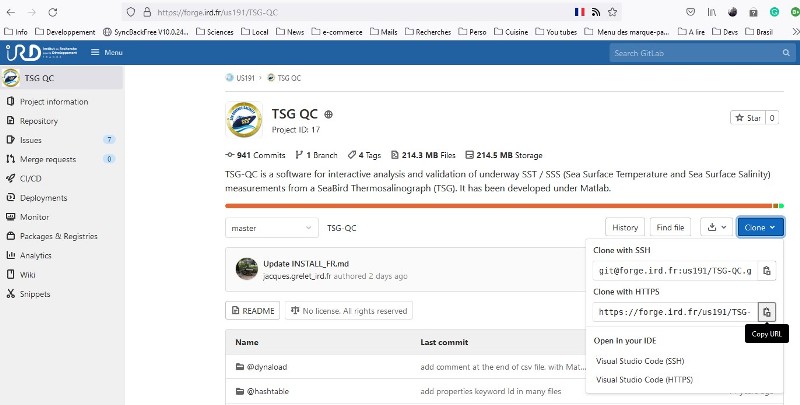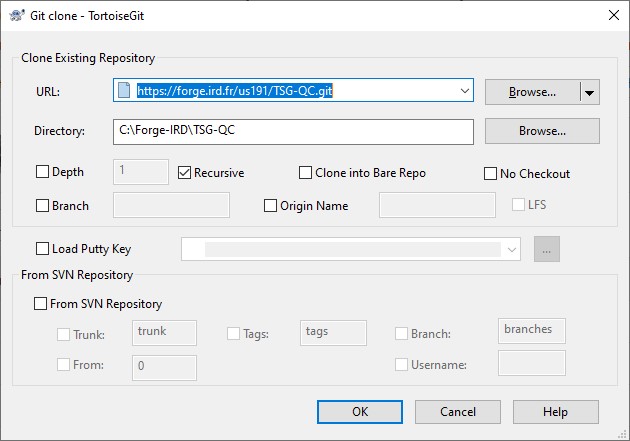TSG-QC: A tool for interactive quality control of sea surface temperature and salinity
Issued Wednesday 25 June 2025.TSG-QC is a software for interactive analysis and validation of underway SST / SSS (Sea Surface Temperature and Sea Surface Salinity) measurements from a SeaBird Thermosalinograph (TSG). It has been developed under Matlab.
Updated on June 25, 2025
PURPOSE
TSG-QC is a tool for analysis and validation of surface temperature and salinity data acquired from a Thermosalinograph (TSG) installed on research or commercial ships.
It allows:
- Visualization of TSG variables: Temperature, salinity, and ship speed
- Interactive comparison with climatological values (WOA and ISAS)
- Automatic quality control using selected threshold criteria
- Data validation and correction with external “bucket” measurements (water samples usually collected once a day)
- Quantitative estimation of sensor drift
The software can deal with different input data formats: ASCII, Labview, "Real-time" Coriolis NetCDF, Seabird (*.cnv), ...
INSTALLING SOFTWARE
The development of the software is now hosted on the IRD Gitlab platform under:
https://forge.ird.fr/us191/TSG-QC
If you have a Matlab license, there are 2 options:
- Retrieve and install the source code of the latest release https://forge.ird.fr/us191/TSG-QC/-/tags/v1.50
Choose the type of archive to download (.zip or .tgz) by clicking on the "Source Code" drop-down menu.
Once the archive is uncompressed on the computer, launch Matlab and add the installation directory of tsgqc on the Matlab path and then launch the software with the command:
tsgqc - Retrieve the sources of the latest version in developmentwith the Git software. If you are running Windows or Linux / Mac, you will need to install the Git software first.
Installing Git:
- Windows: install the software Git and the graphical interface Tortoise, see the post "Install and configure Tortoise Git"
- Linux: follow the instructions described in the official documentation of Git, "Installing Git"
- Mac OsX: https://git-scm.com/download/mac
Clone your local copy of the Git repository:
Go to the TSG-QC Git page https://forge.ird.fr/us191/TSG-QC and copy the HTTPS URL as shown below:

Windows:
In the directory of your choice, for example (c:\gitlab), right-click to open the context menu and choose "Git clone"

then click OK, the cloning of the repository should begin.
Update Deposit: When you’ve been notified by email of adding new features or bug fixes, from the pop-up menu, choose "Git pull" to update your local copy.
Linux:
Clone your local copy of the Git repository on Linux from the command line, replace
Update your local copy:
Versions
The latest version 1.60, updated June 25, 2025 works with the latest versions of Matlab and has been tested up to R2024b.
Read the "Release Notes" file for the latest changes.
Follow the instructions of the files README and INSTALL to modify the paths under Matlab and install the toolboxes or "toolbox" necessary for the application.
Compiled Version:
If you do not have a Matlab license, a compiled version is available by clicking the following links using the ftp client program Filezilla:
Read the file readme.txt.
Using tsgqc.exe requires installing the Matlab runtime. You need to get it from the same link and install it.
To obtain a version compiled under Linux (Ubuntu), send me a direct request by mail.
QUICK START
Start Matlab, go to the tsg_data subdirectory and type tsgqc to run the program. Use the File / Open menu to open a data file.

DOCUMENTATION
A user’s guide is available here
Standards and best practices from GOSUD
OUTPUT FILE FORMAT
The reference document CORTSG_format_gosud.pdf version 3.0 describing the output NetCDF format is available online from the subversion repository.
REFERENCES
- TSG-QC: Talk by Y Gouriou , TSG-CORIOLIS meeting, 01/12/2008
TECHNICAL SUPPORT
If you have any technical difficulties, you can contact me at the following address:
pierre.rousselot_a_ird.fr
Mention the following information:
- a copy of the error message you get in the Matlab Command Window, if any
- the operating system you use (Windows 7, XP, Linux or Solaris):
- Windows: "System Properties"
- Unix: uname -a
under Matlab, the results of the following commands:
- >> ver
- >> matlabpath
LINKS
- SEDOO - SSS
- ORE - SSS: Sea Surface Salinity Observation Service
- SeaBird: Thermosalinograph SBE 21
- GOSUD: Global Ocean Surface Underway Data project
- ODATIS: Ocean Data Information and Services
